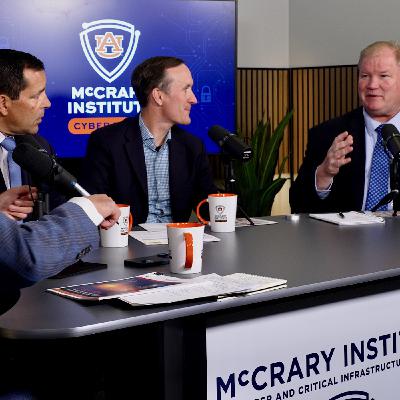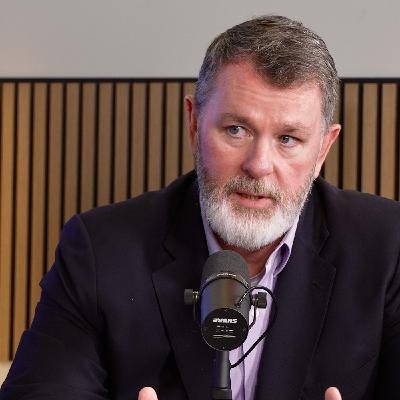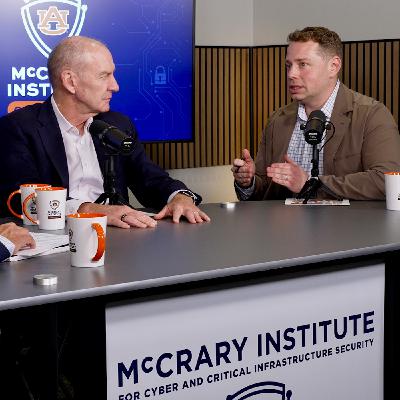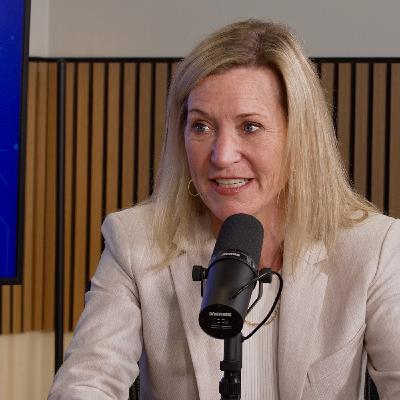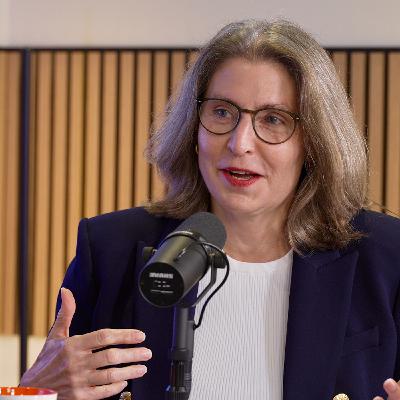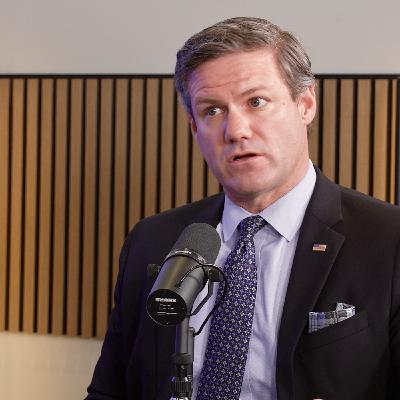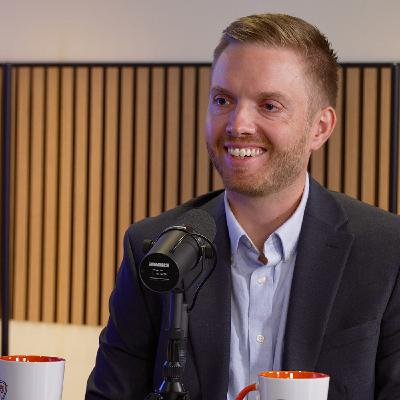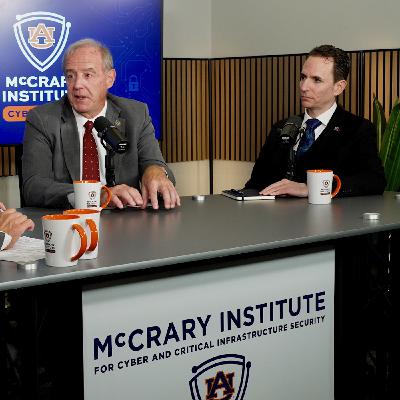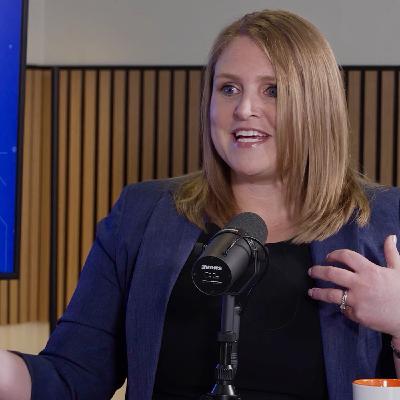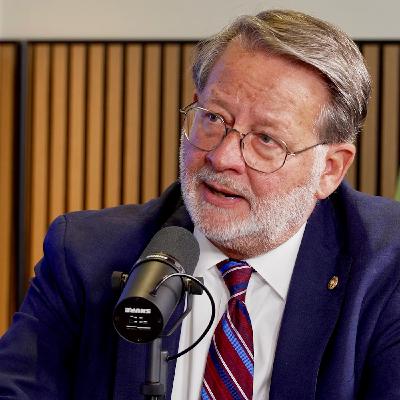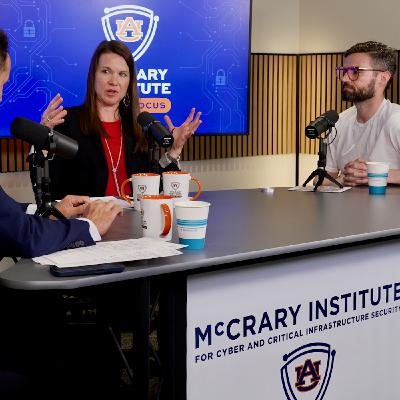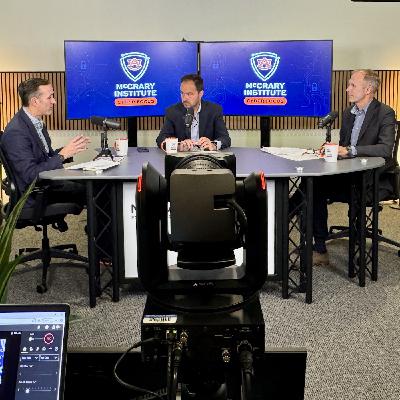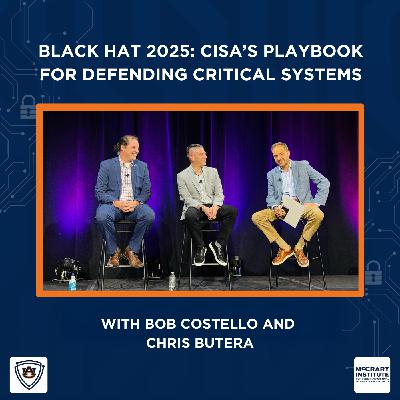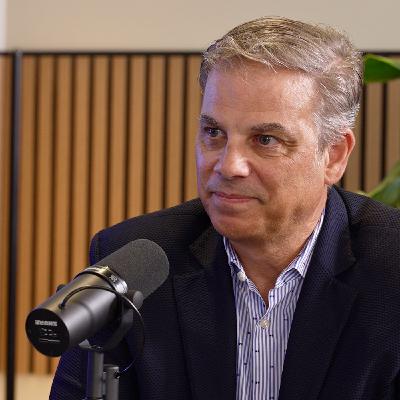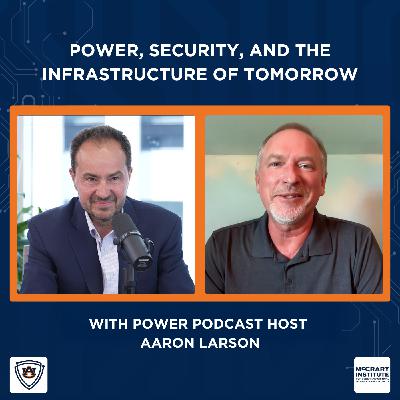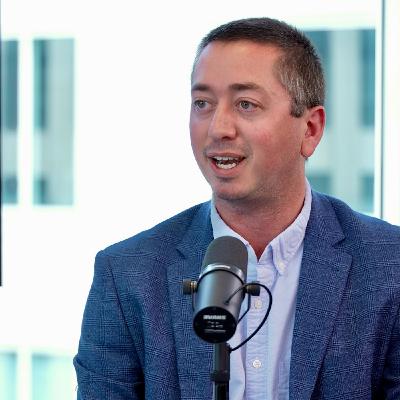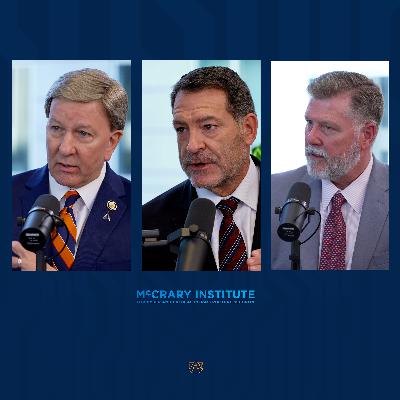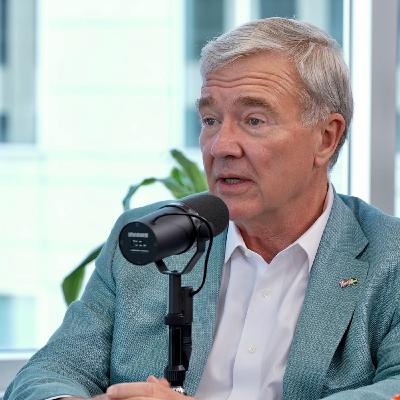Discover Cyber Focus
Cyber Focus

Cyber Focus
Author: McCrary Institute
Subscribed: 5Played: 60Subscribe
Share
© 2025 Cyber Focus
Description
Cyber Focus, from the McCrary Institute, explores the people and ideas that shape and protect our digital world. Each week our host, Frank Cilluffo, speaks with the leading voices in cybersecurity, and brings to light what steps public and private organizations need to be taking to keep our country secure.
97 Episodes
Reverse
What do Volt Typhoon, Salt Typhoon, and Flax Typhoon reveal about China's cyber playbook? This episode of Cyber Focus breaks down a new McCrary Institute report on China's advanced persistent threat campaigns—and what they mean for U.S. national security. Frank Cilluffo sits down with Mark Montgomery, Brad Medairy, and Bill Evanina to explain how China is embedding itself in American infrastructure, telecom, and data systems. They warn that Beijing is laying the groundwork for future conflict and that the U.S. response has been dangerously slow. The guests call for stronger deterrence, better public awareness, and a renewed focus on the economic toll of cyber theft. Main Topics Covered China's long-term cyber threat strategy Volt Typhoon and infrastructure targeting Salt Typhoon and telecom espionage Flax Typhoon and persistent access Gaps in U.S. cyber deterrence Economic costs of IP theft Relevant Links and Resources McCrary Institute Typhoon Report Booz Allen October 2025 China report Key Quotes: "Each year we can say the threat has grown. And I would say the leading driver of that growth in the cyber threat environment in the United States is China." — Mark Montgomery "China is using cyberspace to project power. And as a nation, I think that we need to recognize this threat." — Brad Medairy (~05:50) "Until people believe that [China's cyber actions] matters to them, we're not going to get the kind of actions we need." — Mark Montgomery "China['s] … offensive cyber tradecraft is going to be AI enabled. They're going to be able to deliver effects and capabilities at pace that we never imagined. — Brad Medairy "I think the Chinese want not only us, but they want the world to know that they're inside… Xi wants… the world to know that he can do this." — Bill Evanina "We have to expeditiously get into place where we could harden ourselves so the railroad could work, the ports work, the electricity grids work. We're not ready. We're nowhere near ready." — Bill Evanina Guest Bios: RADM Mark Montgomery (Ret.) is Senior Director of the Center on Cyber and Technology Innovation and a Senior Fellow at the Foundation for Defense of Democracies. He also serves as Executive Director of Cybersolarium.org, a nonprofit advancing the recommendations of the Cyberspace Solarium Commission, which he led from 2019 to 2021. Previously, he was Policy Director for the Senate Armed Services Committee under Senator John McCain, following a 32-year career as a nuclear-trained surface warfare officer in the U.S. Navy, retiring as a Rear Admiral in 2017. Bill Evanina is the Founder and CEO of the Evanina Group, where he advises corporate boards and CEOs on strategic risk, counterintelligence, and national security threats. He served as the first Senate-confirmed Director of the National Counterintelligence and Security Center (NCSC), leading U.S. government efforts to defend against espionage and foreign influence. A 24-year FBI veteran, Evanina held senior roles in both counterintelligence and counterterrorism and previously led the CIA's Counterespionage Group. He also chairs national and international security boards and is an instructor at the University of Chicago. Brad Medairy is an Executive Vice President at Booz Allen Hamilton, where he leads the firm's cybersecurity business and supports national-level clients including the FBI, DHS, DOD, U.S. Cyber Command, and the Intelligence Community. He focuses on protecting critical infrastructure, securing emerging technologies, and defending against advanced cyber threats. Medairy leads multidisciplinary teams that integrate AI, cloud, and cyber operations to deliver full-spectrum solutions. He has been recognized as a Top 50 Cybersecurity Leader and Cyber Executive of the Year, and holds degrees from UMBC and Johns Hopkins University.
What if the easiest way to disrupt U.S. military operations isn't with missiles—but by targeting fuel logistics? In this episode, Chris Cleary explains how civilian infrastructure has become a frontline in national defense. He and Frank Cilluffo discuss how adversaries exploit cyber vulnerabilities to slow military response, and why deterrence requires more than just rhetoric. They unpack the case for a dedicated Cyber Force, the suprising way Chris thinks it should be structured, and the challenges of coordinating across government and industry. With prepositioned threats like Volt Typhoon in the headlines, the stakes are higher than ever. Main Topics Covered How fuel logistics shape U.S. military readiness in the Pacific Why adversaries target civilian infrastructure like water and power systems What defines a "cyber attack" under rules of engagement Gaps in deterrence, response, and public signaling The case for a U.S. Cyber Force modeled after the Coast Guard Challenges of coordination across agencies and private sector providers Key Quotes "I could degrade the Navy's ability to run around in the Pacific by just limiting the ability to move fuel on the west coast of the United States." — Chris Cleary "If [China's cyber forces] are in Littleton, Massachusetts, they're everywhere." — Chris Cleary "I would argue a cyber force of the future looks more like a Coast Guard than a Navy."— Chris Cleary "I am a true believer that cyber is a legitimate means and methods of warfare. And we are going to have to professionalize in it." — Chris Cleary "All the zero trust in the world is not going to stop—a China, a Russia, a sophisticated organization—from targeting you." — Chris Cleary Relevant Links and Resources 60 Minutes on China's Cyber Infiltation: https://www.cbsnews.com/news/china-hacking-us-critical-infrastructure-retired-general-tim-haugh-warns-60-minutes-transcript/ Guest Bio Christopher Cleary is Vice President of Global Cyber Practice at ManTech. He previously served as the Department of the Navy's Principal Cyber Advisor, where he led the implementation of the DoD Cyber Strategy across the Navy and Marine Corps. Prior to that, he was the Navy's Chief Information Security Officer and Director of Cybersecurity within the Department of the Navy CIO's office.
Should the U.S. have a dedicated Cyber Force? In this episode, General Ed Cardon and Josh Stiefel examine persistent gaps in the nation's cyber posture, from undefined mission boundaries to unclear return on billions in cyber spending. They explore the organizational tradeoffs, workforce realities, and coordination challenges that have stalled progress, despite years of warnings. With host Frank Cilluffo, they unpack what it would take to move beyond patchwork solutions. Main Topics Covered The failure of past "wake-up calls" to drive meaningful cyber reform Gaps in command, control, and mission clarity across defensive cyber operations The case for a dedicated Cyber Force and what it would need to solve on day one Why workforce development—not just recruitment—is central to cyber readiness The role of metrics and return-on-investment in cyber spending The importance of establishing clear operational roles between NSA, CNMF, DC3, DCDC Key Quotes: "How many of these have we been through, these quote, unquote, watershed moments that were going to change everything? … How cataclysmic does an incident have to be to get us to actually move one way or the other? - Josh Stiefel "From 2020 to 2025, if you take all the budgets together, we've spent $29.9 billion on cyber operations. That's as much as two Ford-class aircraft carriers. Do we have the equivalent combat capability in cyberspace as two Ford-class carriers? I'd argue no." - Josh Stiefel "[Cyber Com] just is not where it needs to be. It's doing great work, but not at the scale and breadth that we know we're going to need. – Ed Cardon "In my experience, we tend to study [decisions like standing up a Cyber Force] for a couple of years before we implement it. We don't have that kind of time." – Ed Cardon "Each one [of the typhoons] is a really bad day. Collectively, it's the perfect storm. And the fact that we at least publicly haven't made it a much bigger set of issues is going to send a signal to all of our adversaries that this is okay." – Frank Cilluffo Relevant Links and Resources CSIS Cyber Force Commission: https://www.csis.org/programs/strategic-technologies-program/projects/commission-us-cyber-force-generation Guest Bios: Joshua Stiefel is the former Professional Staff Member on the House Armed Services Committee, where he oversaw cyber and IT policy, operations, and procurement. He previously served as Senior Cyber Policy Advisor at the Department of the Treasury, leading sector-wide cybersecurity initiatives and authoring its first vulnerabilities study. A former DoD intelligence officer who deployed with Special Operations Forces in Iraq, he now serves in the U.S. Navy Reserve. He is a Term Member of the Council on Foreign Relations and holds degrees from Harvard and Lehigh. Lt. Gen. Edward Cardon (Ret.) served 36 years in the U.S. Army, including as Commanding General of Army Cyber Command, where he built it into a world-class force with 41 cyber mission teams. He later directed the Army Office of Business Transformation, helping establish Army Futures Command. His career also included leading the 2nd Infantry Division in South Korea and multiple combat deployments. Today, he is a Senior Counselor at The Cohen Group and advises defense and technology organizations.
Katie Gray, a senior partner at In-Q-Tel, joins host Frank Cilluffo to pull back the curtain on the venture firm's role in advancing U.S. national security through tech innovation. As head of In-Q-Tel's cyber investment practice, Gray offers rare insight into the organization's dual-use investment model, its evolving priorities, and the technologies it believes will define the next 25 years. They discuss how In-Q-Tel identifies emerging threats, evaluates startups, and bridges the gap between cutting-edge technology and urgent government needs. Topics include AI, quantum, cyber-physical security, and the vulnerabilities shaping today's threat landscape. The conversation also highlights In-Q-Tel's unique role as both strategic investor and national security partner. Main Topics Covered In-Q-Tel's origin, mission, and evolution beyond the intelligence community How In-Q-Tel identifies promising startups and matches them with agency needs The shifting threat landscape in cyber, including Volt Typhoon and AI-driven attacks Investment priorities in space, supply chain security, and operational technology The dual-use tech model and building resilience at machine speed A case study: VulnCheck and its impact across multiple government agencies Key Quotes "We are dramatically under invested as a nation in our cyber defenses… as we look to the future conflict, we're so vulnerable from a cybersecurity standpoint. " – Katie Gray "[For] every dollar that In-Q-Tel invests in a company, there's $40 that are invested from the private sector." – Katie Gray "One of the things we do look for is to try and fund dual-use technology that has strong commercial [and] government market." – Katie Gray "We're going to be in a world where 80-90% of the code that is being written is being written by AI systems. – Katie Gray "We can't be responding to [AI-driven cyber attacks] at human speed. We have to be responding to that at machine speed." – Katie Gray Relevant Links and Resources https://www.iqt.org/mission https://mccraryinstitute.com/time-to-designate-space-systems-as-critical-infrastructure/ Guest Bio Katie Gray is a senior partner at In-Q-Tel, where she leads the organization's cyber investment practice and supports mission-driven innovation across the U.S. national security landscape. She previously spent more than a decade in software product management, leading development for mobile devices at Palm, HP, and Plastic Logic.
Lisa Plaggemier, Executive Director of the National Cybersecurity Alliance, joins host Frank Cilluffo to discuss how public education can combat online scams, fraud, and cyber threats. With billions of campaign impressions and only a nine-person team, the Alliance focuses on motivating behavior change through creative, jargon-free outreach. Plaggemier explains how scams like pig butchering are orchestrated by organized crime and even nation-state actors—and why the U.S. needs a coordinated national response. The episode highlights the growing need for cross-sector data sharing, targeted messaging for seniors, and a "scam czar" to unite fragmented efforts. As Cybersecurity Awareness Month kicks off, the conversation underscores how individual actions and shared responsibility can help close critical gaps in digital safety. Main Topics Covered • The mission of the National Cybersecurity Alliance and its consumer-focused campaigns • Core Cybersecurity Awareness Month themes: MFA, passwords, updates, and scams • Reaching overlooked populations through creative outreach like Kubikle and safe-word campaigns • The scale and structure of online scams like pig butchering and their ties to nation-state actors • The call for a national "scam czar" to coordinate public-private response • Challenges in cross-sector data sharing and the limits of current fraud response models • Upcoming efforts to reach K-12 audiences and improve campaign impact across age groups Key Quotes "We are a tiny nonprofit of nine people and we reach billions of people every October." — Lisa Plaggemier "I can hack away at our banks and probably not come away with any cash. [But] I can hack away at individual customers of the bank and come away with millions of dollars, and there's no ISAC for my mom." — Lisa Plaggemier "I do not think it would be a bad idea if we had a scam czar at this point because the adversary is so well organized." — Lisa Plaggemier "Older folks are targeted less often, but when they fall victim, the dollar amounts are very high. They have their whole life savings at stake." — Lisa Plaggemier "We've got in a lot of organizations, fraud teams that don't talk to security teams that don't talk to trust and safety teams. And so if you're still siloed in your organization, I think the call to action here is that that all needs to be seen as one." — Lisa Plaggemier Relevant Links and Resources National Cybersecurity Awareness – staysafeonline.org Then & Now: Helping Older Adults Stay Secure Kubikle Series Guest Bio Lisa Plaggemier is Executive Director of the National Cybersecurity Alliance, where she leads efforts to make cybersecurity practical and accessible. She describes herself as "on a crusade to eliminate stock photos of hackers in hoodies," underscoring her focus on real-world education over clichés. A former Ford Motor Company marketing executive, she now serves on the U.S. Secret Service Cyber Investigations Advisory Board and is based in Austin, Texas.
In this episode of Cyber Focus: To the Point, Frank Cilluffo sits down with Matt Hayden, former DHS official and current GDIT executive, to unpack the looming expiration of the Preventing Emerging Threats Act. Together, they explore the growing dangers posed by drones—from hobbyist disruptions to nation-state threats—and what's at stake if Congress fails to reauthorize key counter-UAS authorities by October 1. Hayden explains why current authorities are essential for protecting the homeland and how they fall short when it comes to local law enforcement, airports, and evolving drone technology. Op-Ed: Flying under the radar: Congress is poised to let key counter-drone authorities lapse
What happens when the federal cyber workforce shrinks just as threats are multiplying? In this episode, Federal News Network's Justin Doubleday joins host Frank Cilluffo to unpack the turbulence facing government agencies. They examine the mass departures at CISA, the controversial firings under DHS's Cyber Talent Management System, and the looming risks of dismantling ODNI's cyber intelligence hub. Doubleday also shares a chilling story of how El Chapo's cartel used spyware and hacked city cameras to compromise FBI operations in Mexico—underscoring the new reality of ubiquitous surveillance. The conversation closes with a look at the Pentagon's long-awaited CMMC rollout, Treasury's "Do Not Pay" database, and the broader challenge of protecting both privacy and security in a digital age. Main Topics Covered Why CISA lost a third of its workforce and what that means for U.S. cyber defense How probationary firings under DHS's Cyber Talent Management System shook trust in federal hiring The implications of ODNI shutting down its cyber intelligence integration center amid deep budget cuts Proposals in Congress to speed up security clearances and retain cleared talent longer A chilling account of how El Chapo's cartel hacked FBI operations using spyware and city surveillance What the rollout of DoD's CMMC rules will mean for defense contractors and future cyber regulations How Treasury's "Do Not Pay" database ties into fraud prevention, privacy concerns, and the future of digital identity Key Quotes "A lot of [the departed federal cyber workforce is] on the books until October 1st and so we're kind of waiting to see exactly how many folks left and where the dust kind of settles as we get into the fall." – Justin Doubleday "The probationary firings certainly cast a little bit of a negative light on the idea of joining the Cyber Talent Management System, because… you could be fired with a snap of a finger." – Justin Doubleday "Commercial spyware is much more easily accessible for a range of groups and individuals. And it's almost impossible to detect when spyware has gotten onto a phone of an individual, even for a cyber expert." – Justin Doubleday "I think there's concern that [with ODNI shutting down CTIIC] you're now going to go back to a situation where you have disparate views kind of bubbling up from across the intelligence community and you don't have that single source of truth at the top that's helping to sort things out for leaders." – Justin Doubleday "As it goes with technology and cybersecurity, things are often nice to have until they're necessary." – Justin Doubleday Relevant Links and Resources Cyber pay in government is as fragmented as ever https://federalnewsnetwork.com/federal-report/2024/09/cyber-pay-in-government-is-as-fragmented-as-ever/ CISA at a crossroads amid workforce cuts, pause, partnerships https://federalnewsnetwork.com/cybersecurity/2025/06/cisa-at-a-crossroads-amid-workforce-cuts-pause-partnerships/ Security clearance reforms advancing in 2026 defense bill https://federalnewsnetwork.com/inside-ic/2025/08/security-clearance-reforms-advancing-in-2026-defense-bill/ How a hacker for El Chapo illustrates existential counterintelligence threats https://federalnewsnetwork.com/federal-report/2025/07/how-a-hacker-for-el-chapo-illustrates-existential-counterintelligence-threats/ Grand odyssey of CMMC nearing implementation https://federalnewsnetwork.com/cybersecurity/2025/08/grand-odyssey-of-cmmc-nearing-implementation/ OMB directs agencies to address Do Not Pay data gaps https://federalnewsnetwork.com/financial-management/2025/08/omb-directs-agencies-to-address-do-not-pay-data-gaps/ Guest Bio Justin Doubleday is a reporter for Federal News Network covering cybersecurity, intelligence, and technology policy. He tracks how federal agencies and lawmakers address evolving digital threats, insider risks, and the intersection of policy, procurement, and national security.
Congress faces a looming deadline to renew the State and Local Cybersecurity Grant Program (SLCGP), a federal initiative that helps states and municipalities defend against cyberattacks. In this episode, Frank Cilluffo speaks with New Jersey CISO Michael Geraghty and Arizona CISO Ryan Murray about how these grants are making a measurable difference on the ground. They detail how investments are protecting communities from ransomware, building out shared services, and training the next generation of cyber talent. The conversation underscores the urgency of continued funding to sustain trust, prevent losses, and strengthen the interconnected fabric of U.S. cyber defense. Main Topics Covered Explain why renewing the State and Local Cybersecurity Grant Program (SLCGP) is urgent. Show how federal grants reduce ransomware risk and generate measurable ROI. Use Arizona's student-led SOCs to highlight workforce development and shared services. Describe New Jersey's statewide approach to defending municipalities. Weigh the stakes of eroding trust and services if funding lapses. Explore the broader "one team, one fight" vision linking local, state, and federal defense. Key Quotes: "In the last year, that [endpoint detection] program stopped 179 ransomware attacks…for a $5 million investment, potential loss avoidance is about $45 million." - Michael Geraghty "We're using some of those funds to hire interns as part of our workforce development effort. So we're deploying student-led regional security operations centers in partnership with our community colleges across the entire state [of Arizona]." – Ryan Murray "We're all interconnected, right. Our cities connect to our county governments, connect to our state governments, and we connect to our federal partners. But unfortunately, our defenses have these seams, they have these gaps where we're not so integrated in our defenses and our information sharing." – Ryan Murray "There is no one organization that is going to be able to defend themselves against nation state actors, cyber terrorist organizations, transnational criminal groups, and even the hacktivists or low level hackers. But when we team up together through a strategy that again maximizes our resources, that's when we become that much stronger." - Michael Geraghty "One team, one fight, easier said than done. I think we all know that, but it's challenging." – Frank Cilluffo Relevant Links and Resources CISA SLCGP Fact Sheet NJCCIC (New Jersey Cybersecurity and Communications Integration Cell) Arizona Department of Homeland Security – Cyber readiness resources Guest Bios: Ryan Murray serves as Chief Information Security Officer for the State of Arizona. He previously served as CISO for the Arizona Department of Revenue and has nearly 20 years of IT and security experience. Michael Geraghty is New Jersey's State Chief Information Security Officer and Director of the NJ Cybersecurity and Communications Integration Cell (NJCCIC). He has held senior cybersecurity roles in both the public and private sectors, including the New Jersey State Police and Prudential Financial
Overview Cybersecurity threats are growing more complex as ransomware gangs, nation-states, and criminal networks converge. In this episode, Frank Cilluffo speaks with Cynthia Kaiser, senior vice president at Halcyon and former deputy assistant director for cyber at the FBI. They discuss the looming risk if Congress fails to reauthorize the Cybersecurity Information Sharing Act of 2015, the evolution of ransomware as both a business model and geopolitical weapon, and how industry must play a bigger role in active defense. Kaiser also explains the indiscriminate reach of Chinese espionage campaigns and the urgent need to define national red lines in cyberspace. Together, they outline why collaboration, innovation, and trust are essential to future cyber resilience. Main Topics Covered Halcyon Ransomware Research Center launch FBI lessons from major takedowns Cybersecurity Information Sharing Act stakes Ransomware and nation-state espionage Active defense and industry roles Balancing disclosure and attribution FBI of tomorrow and AI Red lines in cyberspace Key Quotes "If CISA 2015 lapses, companies may be less inclined or may be less able to share information with the government… And then America would be in the dark." – Cynthia Kaiser (~07:37) "There's not one action that's going to stop Putin from cybering… And industry has such a critical role." – Cynthia Kaiser (~11:04) "As a mom… the Chinese government now has information about who [kids] called, where they were, how long the call was… It really shows that the Chinese government is indiscriminate." – Cynthia Kaiser (~22:45) "[Ransomware is] an ecosystem of businesses… And so broadening and being able to conduct more of these proactive active defense operations against criminal groups would have a really great effect." – Cynthia Kaiser (~16:02) "[Washington] should really just be asking 'What are our red lines today, and have we already gone over them?'" – Cynthia Kaiser (~32:16) Relevant Links and Resources Halcyon Ransomware Research Center Fortune op-ed: Cynthia Kaiser on CISA 2015 reauthorization Recent Salt Typhoon joint advisory Guest Bio Cynthia Kaiser is the Senior Vice President of Halcyon's Ransomware Research Center and former Deputy Assistant Director of the FBI's Cyber Division. She led cyber policy, intelligence, and engagement efforts at the Bureau and played a key role in disrupting major ransomware groups like LockBit and Qakbot.
Congress is back from August recess with just weeks to act on vital national issues. One key deadline: reauthorizing the 2015 law that shields companies when they share threat intelligence with the federal government. In this episode, Senator Gary Peters (D-MI) joins host Frank Cilluffo to explain why renewing CISA 2015 is essential to national security, how one senator is holding up progress, and what listeners can do about it. The conversation also covers Peters' push to cut red tape for cyber professionals, shore up state and local defenses, and close critical workforce gaps before it's too late. Main Topics Covered Urgent need to renew CISA 2015 liability protections Misinformation and confusion around CISA's mission Importance of cyber grant funding for state and local governments Regulatory burdens facing cyber professionals and the need for harmonization Federal cyber workforce recruitment and retention Key Quotes "We only have a few weeks and [CISA 2015] will expire, and that will be catastrophic for our ability to protect against all the bad guys that are out there." – Sen. Gary Peters "Trust is everything. And if you don't have [CISA 2015], we go back to the environment we had before where there was a lack of trust… once you lose trust, it's really hard to get it back." – Sen. Gary Peters "Sometimes our cyber professionals spend 40, 50, 60% of their time doing paperwork and checking boxes. That makes no sense." – Sen. Gary Peters "You actually end up saving money by investing in this kind of protection [state and local cyber grants]. And at a time when we're running record deficits that are going to increase, we've got to be thinking about being smart… and actually bringing down the cost of what would happen with a cyber attack." – Sen. Gary Peters "If we don't protect our weakest links, it doesn't matter how good you are at the top—you're going to have some serious problems." – Sen. Gary Peters Relevant Links and Resources Cybersecurity Information Sharing Extension Act Guest Bio Sen. Gary Peters is Ranking Member of the Senate Homeland Security and Governmental Affairs Committee and a nationally recognized leader on cybersecurity policy. A Navy Reserve veteran and former financial executive, he has shaped major legislation on homeland security, cybersecurity, and critical infrastructure—with more bills signed into law than any other senator in a recent session. He also serves on the Appropriations, Armed Services, and Commerce Committees.
In this episode of Cyber Focus, host Frank Cilluffo moderates a timely and wide-ranging conversation on the future of AI policy and governance with Sarah Beth Jansen, a senior fellow at the McCrary Institute and longtime DC policy expert, and Austin Carson, founder of SeedAI and former legislative director for Rep. Mike McCaul. The discussion covers the Trump administration's AI Action Plan, sector-specific regulatory approaches, and how Congress can play a constructive role without stifling innovation. Both guests emphasize the importance of local experimentation, procurement reform, and broad stakeholder engagement. With AI poised to shape everything from national security to everyday business operations, the episode underscores the urgent need to develop trustworthy, inclusive, and forward-looking frameworks that can scale with the technology. Main Topics Covered: The White House's AI Action Plan and why it marks a pivotal policy moment The case for sector-specific approaches to AI regulation The role of Congress in shaping balanced, innovation-friendly guardrails The importance of state-level initiatives like Utah's AI sandbox Federal procurement as a lever for responsible AI adoption Hopes and fears around AI governance and public trust Key Quotes: "We've been using AI or machine learning in our products for over a decade and that's almost a surprise to some members of Congress who haven't really dug into [AI] yet." — Sarah Beth Jansen "AI policy is everything policy now… every single member on the Hill could find something constructive to do involving artificial intelligence in their committee. On one hand, AI is frankly an excuse to find crack back open issues that you may want to crack back open. On the other hand, there is kind of like this infinite fractal space of where AI is going to touch the economy [and] going to touch scientific discovery." — Austin Carson "Before the federal government can come in and say these are what the standards should be… you need to have the ability for there to be input from a variety of different sources." — Sarah Beth Jansen "My biggest fear is that AI will be developed and regulated and considered by a group of extraordinarily small number of people in the bay, and in D.C., and in New York instead of people around the country. — Austin Carson "[Congress] shouldn't be over prescriptive in any legislation they do... because we all know that Congress unfortunately does not pass legislation very quickly. And I think for them to be relevant they need to not be so specific that they just take them themselves out of the game." — Sarah Beth Jansen Relevant Links and Resources: White House AI Action Plan Utah's Office of Artificial Intelligence Policy AI Across America Project Guest Bios: Sarah Beth Jansen is Senior Director of Government Affairs & Policy Counsel at The Franklin Square Group. She's a senior fellow at the McCrary Institute and a seasoned Washington policy expert specializing in cybersecurity, surveillance, and IT policy. She has served in senior staff roles on both the Senate Judiciary Committee and the Senate Homeland Security and Governmental Affairs Committee. She holds degrees from Auburn University and the University of Alabama. Austin Carson is the founder of SeedAI, a nonprofit working to expand public-sector understanding and engagement with artificial intelligence. He previously led government affairs at NVIDIA and served as legislative director for Rep. Mike McCaul when he chaired the House Homeland Security Committee. His work now focuses on facilitating AI literacy and policymaking across sectors and communities.
In this episode of Cyber Focus, Frank Cilluffo is joined by Brad Medairy, Executive Vice President at Booz Allen Hamilton, and Dave Forbes, who leads Cyber Physical Defense for the firm. Together, they unpack their joint report with the McCrary Institute, Anchored in Zero Trust, examining the cybersecurity vulnerabilities of U.S. ports. The conversation explores China's cyber activities, the significance of Volt Typhoon, and the risks posed by Chinese-made cranes operating at American ports. They highlight how economic and national security intersect at ports, the unique challenges of operational technology (OT), and why zero trust must become more than a buzzword. The discussion also looks ahead at how critical infrastructure sectors can harden defenses, reduce tech debt, and build resilience against persistent adversaries. Main Topics Covered China-linked cyber threats to U.S. ports. Risks from Chinese-made cranes; ports as a "one connected battle space." OT basics: know your assets, segment networks, lock down vendor access. Zero Trust for OT: assume breach, pilot fast, scale what works. Why port disruptions matter: major economic ripple effects; plan and drill. What's next: adversarial AI and stronger public-private collaboration. Key Quotes "Our adversary doesn't see the United States infrastructure environment as a Department of Defense, [or] as a global economy, [or] as a Department of Transportation. They see one connected battle space with a great number of… seams that they want to exploit." – Dave Forbes "There's no real intelligence value in terms of what [China was] doing [with Volt Typhoon]. They were pre-staging capabilities in the US critical infrastructure. And the only real explanation is to achieve some sort of potential future kinetic effect." – Brad Medairy "It doesn't need to be a devastating attack. It needs to be a disruption. It needs to be a distraction. It needs to be something that we're worried about… throwing things off balance on our economy and national security posture. – Dave Forbes "Our adversaries don't look at our nation in isolation… They look at our nation as one holistic battle space... So if we flip that… I'm not sure any of us can solve this problem alone, but together we're stronger. – Brad Medairy "[W]e've been able to remediate [Volt Typhoon] in certain cases… That was just step one. This is going to be forever… it's going to be a game of cat and mouse for years to come." – Brad Medairy Relevant Links and Resources Booz Allen Hamilton Cybersecurity Anchored in Zero Trust: Report 'Fast Facts' Anchored in Zero Trust: Full Report Guest Bios Brad Medairy is an Executive Vice President at Booz Allen, where he leads the firm's cyber practice. He is also a Senior Fellow at the McCrary Institute for Cyber and Critical Infrastructure Security, co-leading research efforts on China and cyber threats. Dave Forbes leads Cyber Physical Defense at Booz Allen and was a primary contributor to the Anchored in Zero Trust report. His work focuses on bridging physical and cyber domains to strengthen critical infrastructure protection.
In this special Cyber Focus episode recorded at Black Hat 2025, host Frank Cilluffo sits down with two senior leaders from the Cybersecurity and Infrastructure Security Agency (CISA): Chris Butera, a more than decade-long CISA veteran currently serving as Acting Director of the Cybersecurity Division, and Bob Costello, the agency's Chief Information Officer. They discuss how CISA is adapting its mission in the face of evolving threats, budget pressures, and leadership changes, while maintaining a rapid operational tempo. Topics include the agency's fast-turn vulnerability response through the Known Exploited Vulnerabilities (KEV) catalog, expansion and quality focus of the Common Vulnerabilities and Exposures (CVE) program, and the push to strengthen operational technology (OT) security. The conversation also explores resilience strategies like CISA's new eviction tool, deepening public-private operational collaboration, securing supply chains, and the importance of reauthorizing the Cybersecurity and Information Sharing Act. Main Topics Covered CISA's mission, workforce, and adapting to leadership and budget changes Rapid vulnerability response and the Known Exploited Vulnerabilities (KEV) catalog Threat landscape, including nation-state actors and OT security Operational collaboration with industry, JCDC, and new IT platforms CVE program growth and automation for vulnerability management Resilience strategies, eviction tool, and micro-segmentation Supply chain security and Secure by Demand guidance SLTT cybersecurity grants and field support Importance of reauthorizing the Cybersecurity and Information Sharing Act (2015) Key Quotes: "I'm really honored to work with some of the most experienced cyber professionals I think that exists anywhere in the world… We're seeing people step up into new roles, leadership positions, work on new technical projects that maybe they weren't before. And we're just hitting grand slams every day." – Bob Costello "[I ask organizations] 'How can you continue your mission without access to some of your critical systems? Whether these are your billing systems, your IT systems, your even just access to the Internet.' And I think a lot of organizations don't have those kind of plans in place or can't function in those cases." – Chris Butera "One of the things that we are trying to do every single day is remove some of those OT systems from the Internet. That is a very critical step that we think that there are very few business cases where you should have an OT system connected directly to the Internet." – Chris Butera "We absolutely support reauthorization of [CISA 2015 authorities]… collaboration is what we're all about. We talk about cyber being a team sport and this helps make all the teams play a lot better together." – Bob Costello "I think we all need to think about [supply chains] a lot differently. And it's across the board, whether it's open source, closed source, or hardware, everything is kind of linked together, and often we don't know where those linkages are." – Bob Costello Relevant Links and Resources: CISA Known Exploited Vulnerabilities Catalog Black Hat 2025 Guest Bios: Chris Butera is Associate Director for Cybersecurity at the Cybersecurity and Infrastructure Security Agency (CISA), where he oversees operational efforts to protect the nation's critical infrastructure from cyber threats. Bob Costello is Chief Information Officer at CISA, leading the agency's enterprise IT systems, collaboration platforms, and secure information-sharing initiatives with public and private sector partners.
Forescout CEO Barry Mainz joins host Frank Cilluffo to unpack the evolving cybersecurity threat landscape—from nation-state hacktivism to post-quantum vulnerabilities. Mainz highlights how adversaries are leveraging crowdsourced expertise and agentic AI to target critical infrastructure, especially operational technology (OT) systems in sectors like water, energy, and healthcare. The conversation explores Forescout's research on hacktivist proxy groups, the growing danger posed by embedded and aging devices, and the urgency of preparing for post-quantum cryptographic threats. Mainz emphasizes the need for visibility, containment, and cultural alignment between IT and OT security teams to build genuine resilience in both the public and private sectors. Main Topics Covered: • Hacktivist proxy campaigns and nation-state coordination • Vulnerabilities in critical infrastructure, especially water and energy • Embedded devices and the rise of OT-targeted malware • The looming impact of quantum computing and agentic AI on encryption • Cultural and structural barriers between IT and OT security teams • Practical steps toward building resilience and post-quantum readiness Key Quotes: "Nation state bad actors were using multiple hacktivism groups like an open source… crowdsourced to solve problems… It's not 10 people sitting in a room somewhere, it could be up to several thousand." – Barry Mainz "You can't secure stuff you don't see. So it's really about… asset visibility." – Barry Mainz "If your cyber vendor doesn't have quantum-safe technology built in, it's a problem." – Barry Mainz "The culture is 'Hey, I'm in OT, stay out of my business. I'm in IT, stay out of my business.' And I think this lack of 'Hey, let's go and take an approach together' is missing." – Barry Mainz "Every one of the times we've engaged with a large corporation and they had an issue, it was costing them way more than if they would have just bought the [necessary technology protections] up front." – Barry Mainz Relevant Links and Resources: Forescout's Vedere Labs The Rise of State-Sponsored Hacktivism Forescout Quantum-Safe Solutions Guest Bio: Barry Mainz is the Chief Executive Officer of Forescout Technologies, where he leads the company's mission to secure the world's most critical assets across IT, OT, IoT, and medical device environments. Appointed CEO in early 2023, Mainz brought more than 25 years of executive leadership experience across infrastructure software and cybersecurity, including roles as CEO of MobileIron and President of Wind River Systems, a division of Intel.
In this special crossover edition of Cyber Focus and the Power Podcast, host Frank Cilluffo sits down with Aaron Larson to explore the evolving intersection of energy innovation and cybersecurity. From breakthroughs in small modular reactors and geothermal technologies to the power demands of AI and electric vehicles, they examine how the U.S. grid is being reshaped by both opportunity and threat. Larson draws on his background in nuclear power and conversations with top industry leaders to highlight the promise of emerging energy sources—and the urgent need to bake in security from the start. Together, they underscore the stakes of keeping U.S. energy infrastructure resilient in the face of growing cyber threats and global competition. Main Topics Covered: The transformation of the U.S. power grid from centralized plants to distributed energy resources The impact of AI, data centers, and EVs on electricity demand Innovations in nuclear energy, including SMRs, fusion, and microreactors State-level leadership in clean energy development and workforce transition The need for stronger cybersecurity awareness and integration across the energy sector Strategic competition with China in advanced energy technologies Key Quotes: "We can't [be AI dominant] if we're not energy dominant. The two are inextricably interwoven." — Frank Cilluffo "The nuclear industry will never compromise on safety... because they know any accident at one facility is an accident at all facilities" — Aaron Larson "Volt Typhoon... literally did the cyber equivalent of preparation of the battlefield, where they own that infrastructure and can turn it on or off to meet their needs." — Frank Cilluffo "People know [Cybersecurity] is important...They just don't always think it's their responsibility." — Aaron Larson Guest Bio: Aaron Larson is the Executive Editor of POWER magazine, a team he joined in 2013. Aaron has a bachelor's degree in nuclear engineering technology and a master's degree, specializing in finance. He spent 13 years in the U.S. Navy nuclear power program, advancing to Chief Petty Officer. He has worked at commercial nuclear, biomass, and coal-fired power plants, functioning in operations, maintenance, safety, financial, and management capacities.
Richard Horne, CEO of the United Kingdom's National Cyber Security Centre (NCSC), joins host Frank Cilluffo to explore how the UK is strengthening cyber resilience across critical infrastructure, private industry, and international partnerships. Drawing from his experience in both government and the private sector, Horne outlines NCSC's approach to tackling advanced threats, closing resilience gaps, and collaborating with allies on systemic cyber defense. The conversation spans ransomware, AI, supply chain risk, quantum cryptography, and how organizations—large and small—can better prepare for disruption. Horne emphasizes the growing complexity of the digital threat landscape and urges a pragmatic, contest-oriented mindset to keep pace. Main Topics Covered: The mission and structure of the UK's National Cyber Security Centre (NCSC) Cyber resilience through exposure, defenses, and consequence management Gaps in critical infrastructure protection and supply chain vulnerabilities Use of AI and automation in both defense and attack International collaboration and the importance of Five Eyes partnerships Quantum computing and the need to prepare cryptography for post-quantum threats Key Quotes: "AI is almost like… when we moved from wooden [tennis] rackets to composite rackets. Was that an advantage? It was an advantage to both sides. [...] If you stick with a wooden racket, then ultimately you're going to be overcome." — Richard Horne "We see many cyber attacks exploiting zero-day vulnerabilities that frankly shouldn't be there. And the quality of code that we have in our hardware, software… is a big issue." — Richard Horne "In the world we're in, we all need to recognize we have a responsibility for cyber security for ourselves and for others." — Richard Horne "The relationship with the U.S. and the Five Eyes really does underpin especially our understanding of the most advanced threat." — Richard Horne "You'll often see sort of ransomware attacks against some small company you've never heard of and then potential front page impact the next day." — Richard Horne Related Links: UK National Cyber Security Centre (NCSC) NCSC Cyber Essentials Program Guest Bio: Richard Horne has served as CEO of the UK's National Cyber Security Centre since October 2024. Prior to that, he was a Cyber Security Partner at PwC UK, where he advised global leaders on cyber risk strategy and led responses to major incidents—including the 2021 ransomware attack on Ireland's health service. He previously led cyber risk management at Barclays and played a key role in developing the UK's first national cyber security plan during a stint with the Cabinet Office. Richard holds a PhD in Mathematics and has represented the UK in cybersecurity forums at the OECD, European Commission, and ISO.
Kristina Walter, Director of the NSA's Cybersecurity Collaboration Center, joins Frank Cilluffo to explain how the NSA is building trusted partnerships with private industry to counter advanced cyber threats. Walter shares how collaborative work with defense contractors and tech providers has helped uncover zero-day vulnerabilities, block billions of malicious domains, and expose Chinese operations like Volt Typhoon. She also discusses the role of AI in cyber defense, the race to prepare for quantum computing, and why resilience—not perfection—is the new benchmark for critical infrastructure protection. Main Topics Covered Origins and mission of the Cybersecurity Collaboration Center Building trust and scaling public-private partnerships Tracking Chinese cyber campaigns and zero-day vulnerabilities NSA's protective DNS service and pre-ransomware defense AI's role in threat detection and emerging attack surfaces Post-quantum cryptography and upgrading national systems Workforce development and government-industry collaboration Key Quotes "That service has about 1200 companies enrolled in it today. And it's blocked 4 billion malicious domains… 500 million of them are NSA unique domains." – Kristina Walter "You can't surge trust in a crisis. We have found that having that established relationship meant that when something did go wrong for some of these companies, they knew who to turn to, and how to work with us, and how we would protect the information they gave us". – Kristina Walter "We found it in about two weeks of the start of exploitation and were able to get out the hunting and the detections while the patch was being worked so that we could do it all together and try to remediate the threat." – Kristina Walter "Our focus was… how do we work with interagency partners and industry to expose this trade craft of living off the land… and really unleash the cybersecurity community in the United States to find it and eradicate it on the US Government's behalf." – Kristina Walter "When we talk about a cryptologically relevant quantum computer, it's really [a question of] when, not if… So what we're really focused on is how do we upgrade all of the cryptographic inventory of the United States and national security systems to be quantum resistant." – Kristina Walter Relevant Links and Resources NSA Cybersecurity Collaboration Center NSA AI Security Center NIST Post-Quantum Cryptography Project Guest Bio Kristina Walter is Director of the NSA's Cybersecurity Collaboration Center, where she leads efforts to partner with private industry in defense of U.S. national security systems. A founding member of the center, Walter brings deep experience from her work in both operational cybersecurity and workforce development at NSA. She also oversees the NSA's AI Security Center, advancing the secure development of artificial intelligence technologies while safeguarding U.S. innovation from foreign adversaries.
In this episode of Cyber Focus, Frank Cilluffo sits down with Jonathan Braley, Director of the Food and Agriculture Information Sharing and Analysis Center (Food and Ag-ISAC), to explore the growing cybersecurity threats facing the U.S. food and agriculture sector. They examine the integration of operational technology (OT), the rise in ransomware attacks on farms and food producers, and the fragile nature of supply chain cybersecurity. Braley highlights why even small farms are increasingly targeted and how awareness, threat intelligence sharing, and proactive cyber defense strategies are essential. The discussion also touches on the geopolitical dimensions of agricultural cybersecurity, with examples from Ukraine, Israel, and China. Main Topics Covered: • Why cybersecurity threats matter in the agriculture and food production sector • The risks posed by operational technology (OT) and GPS disruption in precision agriculture • The impact of ransomware attacks on small farms and supply chain resilience • Emerging cyber threats tied to foreign adversaries, disinformation, and intellectual property theft • New technologies in agriculture: AI tools, drones, and autonomous farming systems • The importance of cyber threat intelligence sharing and public-private collaboration in agriculture Key Quotes: "Historically we all have this picture of a farm in our heads with the manual tractors and people out on the fields. But there's a lot of technology now baked into the food and agriculture sector." – Jonathan Braley "If we're relying on our precision agriculture without a backup plan, when [GPS] goes down, it's not going to be a good situation for us." – Jonathan Braley "Anywhere along that [supply] line, one of those companies has a cyber incident—it's going to impact everybody." – Jonathan Braley "The ransomware group seemed to have an understanding of the nature of food and ag, and they hit them when it was most impactful [during peak planting and harvesting season]." – Jonathan Braley "The more we can share with each other [across government and industry], I think we have a better chance of protecting ourselves." – Jonathan Braley Relevant Links and Resources: • Food and Ag-ISAC: https://www.foodandag-isac.org/ • Cybersecurity Information Sharing Act of 2015 (CISA) Guest Bio: Jonathan Braley is the Director of the Food and Ag-ISAC, a key hub for cybersecurity information sharing across the food and agriculture sector. He also serves as Director of Threat Intelligence at the IT-ISAC, where he supports some of the world's leading technology companies. Braley's work focuses on improving cyber resilience in agriculture, helping farms, suppliers, and food producers detect and defend against ransomware, OT threats, and supply chain vulnerabilities.
In this special Independence Day episode of Cyber Focus, we bring together highlights from three influential House leaders shaping U.S. cyber policy: Chairman Mark Green (Homeland Security), Chairman Mike Rogers (Armed Services), and Chairman Rick Crawford (Intelligence). From digital warfare and offensive cyber capabilities to workforce development and interagency reform, this episode offers a rare look into how Congress is working to strengthen national security in the digital age. Listen to their full interviews: • Rick Crawford – We Are in a State of Digital Warfare https://mccraryinstitute.com/podcast/cyber-focus/76/we-are-in-a-state-of-digital-warfar/ • Mike Rogers – Cyber, Space, and the Future of Warfare https://mccraryinstitute.com/podcast/cyber-focus/64/cyber-space-and-the-future-of-warfa/ • Mark Green – Bridging the Cybersecurity Gap https://mccraryinstitute.com/podcast/cyber-focus/9/bridging-the-cybersecurity-gap-cong/
In this urgent episode of Cyber Focus recorded June 24, 2025, host Frank Cilluffo speaks with retired General Frank McKenzie, former Commander of U.S. Central Command and Executive Director of the Global and National Security Institute at the University of South Florida. The discussion focuses on the unfolding crisis between Iran and Israel, recent U.S. military strikes on Iranian nuclear sites, and the fragile ceasefire now in place. McKenzie offers expert insight into the strategic weakness of Iran, the state of its proxy forces, and the growing threat of Iranian cyberattacks. They also examine how Russia and China are positioning themselves amid the turmoil, the state of U.S. missile defense systems, and what Americans should watch for when it comes to national and homeland security. Main Topics Covered: Iran's weakened military and the strategic calculus behind the current ceasefire U.S. bunker-busting strikes and implications for Iran's nuclear program The future of Iran's proxy forces and risks of terrorism and radicalization China and Russia's interests in the Middle East crisis Iran's cyber threat posture and U.S. digital vulnerabilities Space-based missile defense and the future of homeland security strategy Key Quotes: "Iran badly needs a ceasefire. They need to stop the bombardment because they're losing." — General Frank McKenzie (Ret.) "The fact of the matter is Iran has had poor luck operating in the United States… they're not adept at operating in this environment." — General Frank McKenzie (Ret.) "I think self radicalization is probably more of a threat… than a highly organized Iranian attack in the United States or through one of their proxies. But you can't rule it out." — General Frank McKenzie (Ret.) "They do have the ability to attack us here with cyber… they will go where we're weakest." — General Frank McKenzie (Ret.) "If we want to defend the United States against attacks like this from intercontinental ballistic missiles, we're going to have to be prepared to put systems on orbit, persistent systems on orbit." — General Frank McKenzie (Ret.) Relevant Links and Resources: Global and National Security Institute at the University of South Florida Cyber Florida – The Florida Center for Cybersecurity U.S. Central Command (CENTCOM) NTAS Bulletin – National Terrorism Advisory System Guest Bio: General Frank McKenzie (Ret.) is the Executive Director of the Global and National Security Institute at the University of South Florida and former Commander of U.S. Central Command (CENTCOM). A retired U.S. Marine Corps General, McKenzie brings decades of experience in Middle East operations, nuclear deterrence, and national security strategy. He is a leading voice on cybersecurity, defense policy, and military readiness in the face of global threats.


